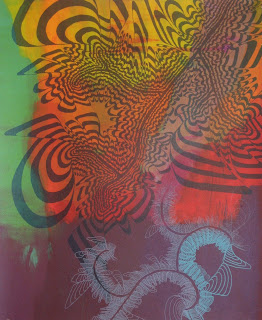Whilst visiting family last week I went to the Yorkshire Sculpture Park for the afternoon. I have never been before and it is a lovely site to walk around with the added bonus of some contemporary art to view. Some work is in a couple of galleries, but much of it out and about in the parkland. For me it raised a lot of questions about the appropriateness of some of the work in such a setting and the old chestnut of what makes a work of art. This became encapsulated after having walked down David Nash’s recent installation 71 Steps and then over a bridge that was part of the original 18th Century Estate to overhear a lady saying ‘I don’t think that’s a sculpture, it’s just a bridge’.
 |
| 71 Steps - David Nash |
Well she was just heading towards the steps and in some way the same comment could be made, they are just steps. How much difference does it actually make that they have been installed by an artist, carefully selecting oak wood that has been charred black and oiled and set into the lie of the land with 30 tonnes of coal set between the steps. All to reflect the local environment as well as past industries and expected to erode back over time into the setting. Yes they are just steps but they are also more than that as well as they could have been made without such considerations resulting in something far less fitting. It is perhaps a fine line between the two.
 |
| The Outclosure, in the centre of the wooded enclosure |
For me the most fascinating works were those by Andy Goldsworth, they really fitted their sites but also questioned them directly. ‘Outclosure’ is a closed circular stone wall, set across a path that runs through an original enclosure on the estate that protects a small wooded glade. It disrupts the flow of people as they walk through the wood and draws attention to the areas we have access to and what walls are used for.
Another work is ‘Hanging Tree’, following a dry stone wall that runs the length of the estate’s original ha-ha, three rectangular enclosures in the wall become apparent, however as you approach them you see trees suspended in the wall enclosure and that these are actually very deep openings. You are rewarded in walking up to them, as it could be assumed that they are just mere fluctuations of the wall when in fact they are much more.
 |
| Part of Hanging Tree |
 |
| Hanging Tree - Andy Goldsworthy |
Around the estate are also a number of works by Henry Moore and Barbara Hepworth, both Yorkshire born. Such placing certainly gives them plenty of space to be viewed from all angles, rather than in some cramped gallery but I’m not sure how much they actually belong to such spaces. Even when an artist has deliberately selected a location for a work, such as Sol LeWitt’s ‘123454321’. LeWitt is an artist whose work I have often admired for the strategies and ideas that he employs but I’m not sure how much this work gains in its location over being somewhere else.
 |
| Sol LeWitt 123454321 |
There were many more works and thoughts from this trip more than can be really fitted in here. I can only recommend you take your own visit, and if that is not possible, spend a little while looking over their
website as they have some excellent photos and descriptions.







































